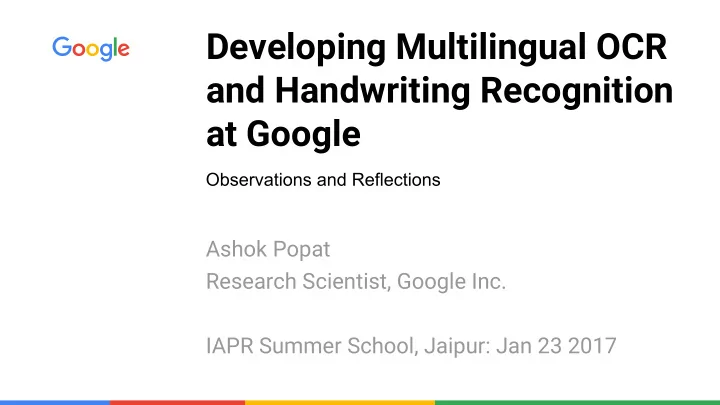

Developing Multilingual OCR and Handwriting Recognition at Google Observations and Reflections Ashok Popat Research Scientist, Google Inc. IAPR Summer School, Jaipur: Jan 23 2017 Ashok Popat, Jan 23, 2016
Joint work with Jon Baccash Yasuhisa Fujii Marcos Calvo Philippe Gervais Victor Cărbune Pedro Gonnet Thomas Deselaers Patrick Hurst Karel Driesen Henry Rowley Sandro Feuz Li-Lun Wang Ashok Popat, Jan 23, 2016
Optical Character Recognition Ashok Popat, Jan 23, 2016
OCR in Google Products
Google Handwriting Input on-device recognition > 80 languages + emoji
Google Translate for Android Translate 2.3 Translate 2.4+ enabled by default only for CJ enabled for all supported lang.
Handwrite for Mobile Search write your search right on the Google homepage available on Google.com from smartphone or tablet can be activated or disabled in mobile search settings
Other Applications Input tools … and more Other input methods for Android
Outline ● Multilingual OCR and On-line handwriting systems Research at Google ● ● Personal observations, reflections Ashok Popat, Jan 23, 2016
Part 1a: A multilingual OCR system Ashok Popat, Jan 23, 2016
Examples from Google Books Multiple scripts / languages on a page: Ashok Popat, Jan 23, 2016
Examples from Google Books (cont.) Per-word script and language variation: Ashok Popat, Jan 23, 2016
Examples from Google Books (cont.) Ashok Popat, Jan 23, 2016
Some of the 26 scripts of interest Ashok Popat, Jan 23, 2016
Starting point: Markov-model-based approaches ● Document image decoding [Kopec and Chou, 1994] Explicit model of typesetting process: seek to invert ○ ○ Influenced by speech recognition methods Extremely high accuracy when models match the data ○ ● BBN Byblos system [Schwartz et al., 1996] ○ Treat text line like a speech waveform Built on existing speech recognition system ○ ○ First successful Arabic OCR Ashok Popat, Jan 23, 2016
Generalization of the noisy channel model ● Speech approach ● Generalize to multiple feature functions ● Learn {λ} via minimum error-rate training [Macherey et al. ‘08, Och ‘03] Ashok Popat, Jan 23, 2016
Minimum Error Rate Training Macherey, Och, Thayer, Uszkoreit: Lattice-based Minimum Error Rate Training for Statistical Machine Translation. EMNLP 2008.
Training flow Text data Text data Optical model Language model training training Unsupervised data HMM LM Rendering w/ degradation Labeled data MERT Decode Self-labeled data OCR Training data system Confidence filtering Evaluation Labeled data Packaging
Technical evolution ● Optical model GMM -> DNN ○ ○ DNN -> LSTM Sequential discriminative training of DNN/LSTM ○ ● Language model N-gram -> RNN-LM ○ ● Decoding ○ Pruning algorithms designed for OCR Automatic decoding parameter optimization ○ ○ Fujii et al., ICDAR’15 Ashok Popat, Jan 23, 2016
Script ID (Li et al., 2015) Ashok Popat, Jan 23, 2016
Regions not covered Ashok Popat, Jan 23, 2016
Part 1b: A multilingual handwriting recognition system Ashok Popat, Jan 23, 2016
Segment and Decode Hidden Markov Models neural network variants: Recurrent, Time-Delay, Long Short-term Memory Apple Newton [Yaeger 1996] [Jaeger 2001], [Graves 2009], ... Microsoft Tablet PC / Vista [Pittman 2007]
Segment and Decode 1: Creating a segmentation lattice
Segment and Decode 2: recognizing character hypotheses
Segment and Decode 3: Decoding
Feature Function Weights Label " i " Feature functions values: 0.1 – character score 0.9 – language model score determine edge 2.3 – relative size to neighbors score as 0.2 – cut score weighted sum Label " é " [...]
Features: Per character hypothesis ● Histograms of point features (3210 dimensional) ● Bitmap features: 3x8x8 pixels (192 dimensional) ● Simple statistics (384 dimensional) ● Water reservoir features (64 dimensional) ● Stroke direction (180 dimensional) ● Quantized stroke direction maps (512 dimensional)
More feature functions ● string length ● character prior segmenter cut features ● relative size ●
Part 2: Research at Google Ashok Popat, Jan 23, 2016
Google’s Hybrid Approach to Research Spector, Norvig, Petrov ‘12 Comm. of the ACM ● Pattern 2: Small research team builds a system that gets deployed. “This pattern applies best when continuing research can further improve and extend the resulting products.” Ashok Popat, Jan 23, 2016
Enablers ● Single code base, wide range of library functions Infrastructure ● ● Expertise and skills of other teams ● Data Ashok Popat, Jan 23, 2016
Enablers (cultural) ● Transparency and cooperation Peer review ● ● Respect and psychological safety ● Team- and personal-level pace and execution ● Data-centrism Ashok Popat, Jan 23, 2016
Software engineering ● Respected and valued If it’s not checked in, it doesn’t exist ● ● Toy prototypes versus production-quality code ● A day in the life: 80/20 Ashok Popat, Jan 23, 2016
Part 3: Observations and Reflections Ashok Popat, Jan 23, 2016
Translation quality: Franz Och et al., NIST’06 Ashok Popat, Jan 23, 2016
Rapid real progress ● Multiple contributors, one system Industry folks at NIST’06 meeting were startled ● ● Incentive: get a real gain, check it in quickly ● From each according to ability ● Data is important; eval data is paramount Ashok Popat, Jan 23, 2016
Keeping it real ● Working, deployed system that solves a whole problem Tight feedback loop ● ● Everything that matters gets measured Ashok Popat, Jan 23, 2016
Pedestrian approaches versus cutting edge ● Translate: world-beating and obsolete Data versus Syntax ● ● Language modeling: “Stupid Backoff” (Brants et al., 2007) ● When and how to invest in promising researchy approaches? Ashok Popat, Jan 23, 2016
Reward and recognition ● Cleverness, independence, origination of new ideas? Cooperation, generosity, communication, productivity, risk taking? ● ● Imposter syndrome ● Happiness Ashok Popat, Jan 23, 2016
Summary: what’s worked for me? ● Work on real systems Measure what matters ● ● Incent the right things ● Keep aware of new research while investing conservatively Ashok Popat, Jan 23, 2016
Then and now Ashok Popat, Jan 23, 2016
Thank you! Ashok Popat, Jan 23, 2016
Recommend
More recommend